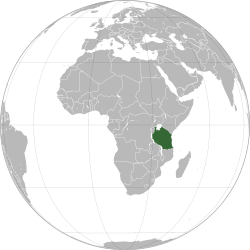Complete ecotouristic information database on national parks of Tanzania.
Tanzania is a state in central East Africa bordered by Kenya and Uganda to the north, Rwanda, Burundi  and the Democratic Republic of the Congo to the west, and Zambia, Malawi and Mozambique to the south. The country's eastern borders lie on the Indian Ocean. The name Tanzania is a portmanteau of Tanganyika and Zanzibar. The two states united in 1964.
and the Democratic Republic of the Congo to the west, and Zambia, Malawi and Mozambique to the south. The country's eastern borders lie on the Indian Ocean. The name Tanzania is a portmanteau of Tanganyika and Zanzibar. The two states united in 1964.
Tanzania is probably one of the oldest known continuously inhabited areas on Earth; fossil remains of humans and pre-human hominids have been found dating back over two million years.
At 947,300 km², Tanzania is the world's 31st-largest country (after Egypt) and the 13th largest in Africa. It is comparable in size to Nigeria.
Tanzania is mountainous in the northeast, where Mount Kilimanjaro, Africa's highest peak, is situated. Three of Africa's Great Lakes are partly within Tanzania. To the north and west lie Lake Victoria, Africa's largest lake, and Lake Tanganyika, the continent's deepest lake, known for its unique species of fish. To the southwest lies Lake Nyasa. Central Tanzania is a large plateau, with plains and arable land. The eastern shore is hot and humid, with the Zanzibar Archipelago just offshore.
Tanzania has a tropical climate. In the highlands, temperatures range between 10 and 20 °C during cold and hot seasons respectively. The rest of the country has temperatures rarely falling lower than 20 °C. The hottest period extends between November and February (25–31 °C) while the coldest period occurs between May and August (15–20 °C). The climate is cool in high mountainous regions.
Tanzania has two major rainfall regimes. One is uni-modal (October–April) and the other is bi-modal (October–December and March–May). The former is experienced in southern, central, and western parts of the country, and the latter is found in the north from Lake Victoria extending east to the coast. In the bi-modal areas, the October–December rains are generally known as the short rains. The March–May rains are referred to as the long rains.
Vast plains full of typical African animals can be found in most Tanzanian national parks. It was right here where some of the most famous films about African nature were made. Serengeti or Ngorongoro are only two of many national parks which probably everybody has heard about.
It is almost certain that a visitor of these parks will see herds of grazing antelopes, giraffes, elephants, lions and other big mammals that appear in films about Africa. Appart from this, with us you will see that nature in this beautiful country is much more diverse and smaller animal species are as interesting as the big ones. The Tanzanian national parks are not only savannas – Kilimanjaro with its unique flora which is so different from the flora of surrounding savannas. In another park you can see as well the lakes of the Great Rift Valley, where beside the big lakes (e.g. Victoria´s Lake) you can visit smaller salty or alum lakes with countless flocks of flamengos.
Detailed information on Tanzania National Parks.
There is a database of this country national parks available. If you have any question or request you can send it by attached Informative Form.